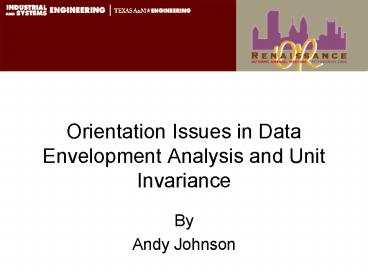Orientation Issues in Data Envelopment Analysis and Unit Invariance - PowerPoint PPT Presentation
1 / 26
Title:
Orientation Issues in Data Envelopment Analysis and Unit Invariance
Description:
New Optimality Principles for Economic-Efficiency and Equilibrium. ... Even though we have parameters for certain cases, the problem still exists the ... – PowerPoint PPT presentation
Number of Views:90
Avg rating:3.0/5.0
Title: Orientation Issues in Data Envelopment Analysis and Unit Invariance
1
Orientation Issues in Data Envelopment Analysis
and Unit Invariance
- By
- Andy Johnson
2
Outline
- Brief Background
- Directional Distance Function
- Alternative 1 for the estimation of the
parameters of the distance function - Alternative 2
- Unit invariant directional model
Introduction
3
Efficient Frontier
output
Efficient Frontier
d
f
i
c
e
b
h
g
a
j
input
Introduction
4
Measuring Efficiency and Orientation
output
Efficient Frontier
d
f
i
c
e
o
b
h
g
a
j
input
Introduction
5
Efficient Frontier and Orientation
output
Efficient Frontier
d
c
e
b
a
input
i
Introduction
6
Orientation in DEA
output
Efficient Frontier
e
input
Introduction
7
Orientation in DEA
- The orientation decisions impacts both the
measure of efficiency (assuming variable returns
to scale) and the benchmark identified
Introduction
8
Directional DEA
Luenberger, D. G. (1992). "New Optimality
Principles for Economic-Efficiency and
Equilibrium." Journal of Optimization Theory and
Applications 75(2) 221-264. Chambers, R. G., Y.
H. Chung, et al. (1996). "Benefit and distance
functions." Journal of Economic Theory 70(2)
407-419. Chambers, R. G., Y. Chang, et al.
(1998). "Profit, directional distance function,
and Nerlovian efficiency." Journal of
Optimization Theory and Application 98(2)
351-364.
Directional DF
9
Directional DEA
output
Efficient Frontier
e
input
Directional DF
10
Directional DEA
- This allows the direction to be flexible
- Is still a linear program
- However, it does not preserve unit invariance
Directional DF
11
Directional DEA
- How does one decide the values for and ?
- The direction not only impacts the efficiency
estimate but also impacts the virtual observation
identified for benchmarking purposes
Directional DF
12
Directional DEA Dual
Directional DF
13
Estimating and
- Additional information is needed
- One source of information could be multiple
observations of the same production units over
time (time series data) - Given time series data and assuming production
units are effectively working toward increased
technical efficiency over time
Directional DF
14
Directional DEA
output
e
input
Alter. 1
15
Estimation Procedure
- For a single output multiple input model
- Define a value for .
- Ex.
- Next regress
- Set
Alter. 1
16
Limitations of this Approach
- Only allows for a single input multiple outputs
or a single output multiple inputs - If the production unit is growing rapidly over
time so that not only are output levels
increasing, but input levels are increasing
significantly, then could be negative which
is inconsistent with the modeling assumptions
(and efficiency measurement in standard models of
performance)
Alter. 1
17
Alternative Approach to Estimating and
- Want to estimate the directional parameters in
such a way that variables that are difficult to
adjust receive low parameters and variables that
are easy to adjust are given larger parameters
Alter. 2
18
Alternative Approach to Estimating and
- Use the ratio of the variance to the mean over
the time periods observed
Alter. 2
19
Alternative Approach
- Benefits
- and always have the proper sign
- Estimates are based on the flexibility of the
inputs and outputs - Drawbacks
- Even if a variable is very flexible, if the firm
does not change the usage level, the directional
parameter assigned to that input or output would
be small
Alter. 2
20
Unit Invariance
- Even though we have parameters for certain cases,
the problem still exists the directional distance
function model is not unit invariant
Unit Invariant
21
Fare-Lovell Technical Efficiency Measure
Briec, W. (2000). "An extended Fare-Lovell
technical efficiency measure." International
Journal of Production Economics 65 191-199.
Unit Invariant
22
Fare-Lovell Technical Efficiency Measure
- Benefit
- Directional while maintaining unit invariance
- Drawbacks
- Combines the Russell input and Russell output
measures which weight each input and output
equally - The solution are on the range of 0 to -1 with 0
being efficient, which is counter intuitive
Unit Invariant
23
New Directional DEA
Unit Invariant
24
New Directional DEA
- Benefits
- Unit invariant and allows for flexibility in the
direction of improvement - Generalizes Shephards input and output distance
functions and the directional distance function
when is chosen - Ranges from 0 to 1 with 1 indicating efficient
operation
Unit Invariant
25
Summary
- Directional DEA models are important because they
capture the flexibility (or lack there of) of the
inputs and outputs - Two alternatives have been developed for
estimating the directional parameters - Each has benefits and drawbacks
- A directional model that is unit invariant has
been developed incorporating one of the most
important properties of efficiency measure into
directional models
26
Any Questions?
- Andy Johnson
- ajohnson_at_tamu.edu































